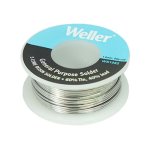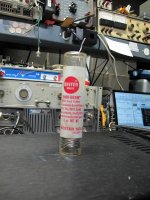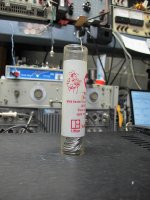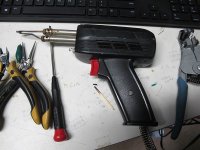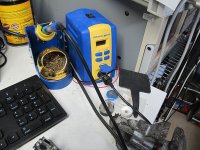Poor soldering can be a few things.
1/ Bad tip.
2/ Corroded or untinned pcb.
3/ Iron too hot or too cold.
4/ Poor soldering technique. Heat component leg and pcb pad for a second before applying solder.
5/ Solder with insufficient flux.
6/ Solder with very high melting point.
7/ Too small a tip or soldering iron wattage insufficient.
Leaded solder works best for me.
1/ Bad tip.
2/ Corroded or untinned pcb.
3/ Iron too hot or too cold.
4/ Poor soldering technique. Heat component leg and pcb pad for a second before applying solder.
5/ Solder with insufficient flux.
6/ Solder with very high melting point.
7/ Too small a tip or soldering iron wattage insufficient.
Leaded solder works best for me.
Early use of unleaded solder in satellites caused problems with tin whiskering causing shorts years later.I use leaded solder although I am ready to use the new unleaded solders if they have very similar properties like leaded solder. I have read that modern solders are brittle and they tend to develop dry joints after some years. If this is not true I might consider using non-leaded solder.
I've written quite a bit on the topics of solder and soldering irons. You can find my thoughts here:
How to choose solder for electronics – Neurochrome.
Choosing a soldering iron – Neurochrome.
I would definitely stick to 63/37 Sn/Pb or 60/40 Sn/Pb if you can find it. 0.7-0.8 mm is good for PTH technology. 0.4-0.5 mm would be my choice for SMD.
If you cannot find leaded solder, go for AIM Sn100C or similar. It's 99.25 % tin, 0.7 % copper, trace amounts of nickel (0.05%) and other elements to make it flow better. Similar solders are marketed as 99.3/0.7 Sn/Cu which is available with and without germanium or bismuth doping. The dopants supposedly help getting the solder to flow better.
SAC305 (96.5/3/0.5 Sn/Ag/Cu) is awful stuff. It doesn't flow nicely, doesn't want to stick to anything, and results in grainy looking solder joints that are indistinguishable from cold joints made with 60/40 Sn/Pb. It's used for automated assembly in controlled processes and it's fine for that. But I would definitely not recommend it for the hobbyist.
Tom
How to choose solder for electronics – Neurochrome.
Choosing a soldering iron – Neurochrome.
I would definitely stick to 63/37 Sn/Pb or 60/40 Sn/Pb if you can find it. 0.7-0.8 mm is good for PTH technology. 0.4-0.5 mm would be my choice for SMD.
If you cannot find leaded solder, go for AIM Sn100C or similar. It's 99.25 % tin, 0.7 % copper, trace amounts of nickel (0.05%) and other elements to make it flow better. Similar solders are marketed as 99.3/0.7 Sn/Cu which is available with and without germanium or bismuth doping. The dopants supposedly help getting the solder to flow better.
SAC305 (96.5/3/0.5 Sn/Ag/Cu) is awful stuff. It doesn't flow nicely, doesn't want to stick to anything, and results in grainy looking solder joints that are indistinguishable from cold joints made with 60/40 Sn/Pb. It's used for automated assembly in controlled processes and it's fine for that. But I would definitely not recommend it for the hobbyist.
Tom
Those issues have been ironed out though.Early use of unleaded solder in satellites caused problems with tin whiskering causing shorts years later.
Tom
Have a look at the Wiki page on solder alloys :
https://en.m.wikipedia.org/wiki/Solder_alloys
Loads of info there, I would definitely choose a eutectic solder - personally I use Pb37 Sn63. Other eutectic alloys with fancier compositions including Ag and or Cu exist - that page has a summary of the properties & recommended uses for each.
https://en.m.wikipedia.org/wiki/Solder_alloys
Loads of info there, I would definitely choose a eutectic solder - personally I use Pb37 Sn63. Other eutectic alloys with fancier compositions including Ag and or Cu exist - that page has a summary of the properties & recommended uses for each.
Last edited:
I use MG Chemicals 4880 in 0.032” diameter. This uses an RA flux that should be cleaned afterwards with a compatible RA cleaner. I am likely going to move to a variant with a no-clean flux to avoid any corrosive action later on.
I also keep a flux pen of MG Chemicals 835-P on hand for fine solder pads and wires, and it’s supposed to be non-corrosive.
A lot of people like Kester 24-6337-0027 leaded solder.
I also keep a flux pen of MG Chemicals 835-P on hand for fine solder pads and wires, and it’s supposed to be non-corrosive.
A lot of people like Kester 24-6337-0027 leaded solder.
Used to have a one pound spool of Kester 60/40 rosin core and it worked great for years. Ran low on it a while back so bought more Kester rosin core, this time # 2463370027 - 63/37. Even better than the old 60/40 was!
Solder flows very nicely and joints look shiny & beautiful.. I think you can’t go wrong with a new roll of Kester.
Solder flows very nicely and joints look shiny & beautiful.. I think you can’t go wrong with a new roll of Kester.
I wouldn't get too wound up about eutectic vs not as long as the non-eutectic solder has a relatively narrow plastic region. I've never had issues soldering with 60/40 Sn/Pb, which is not eutectic, for example. That said, if you're buying a fresh roll of solder I think it makes sense to go for the eutectic alloys. It's just one less thing to worry about. They're just nicer to work with.
Tom
Tom
I use the cheap Weller stuff from Bunnings for most of my work:
https://www.bunnings.com.au/weller-...older_p0248145?store=5212&gclsrc=ds&gclsrc=ds
Still have a small spool of quality 0.5 mm 60/40 solder from the time when was working in the trade.
The best I had was a 60/37/3 tin/lead/copper which alas I can not find anymore, at least for a decent price locally.
Refuse to buy off ePay or Jaycar as the quality is really questionable.
Use an old Hakko 926 and because I've been doing it for 30 odd years I'm comfortable using a single chisel type tip for all my work. Max temp that I use is 350 C, but most of the time stay between 300 - 320.
All the advices to use higher temps are risky and ill informed to say the least.
It's not just temperature, but the quality of solder, the power of your iron, the size tip, the size of the solder pad, the ambient temperature and so on.
Pre-tinning legs of passive components, pre-tinning the iron tip, also cleaning it before every single solder spot are mandatory if one wants reliability.
You should not stay on a single pad for more than 2 - 3 seconds. If it takes longer it means either the solder is not right, the temp is not right, the tip is not right, cleanliness is not right, your iron is under powered.
Never use flux unless I need to de-solder a very heavy wire or terminal and do it without damaging the pad. The risk of lifting pads, especially with old equipment is huge.
https://www.bunnings.com.au/weller-...older_p0248145?store=5212&gclsrc=ds&gclsrc=ds
Still have a small spool of quality 0.5 mm 60/40 solder from the time when was working in the trade.
The best I had was a 60/37/3 tin/lead/copper which alas I can not find anymore, at least for a decent price locally.
Refuse to buy off ePay or Jaycar as the quality is really questionable.
Use an old Hakko 926 and because I've been doing it for 30 odd years I'm comfortable using a single chisel type tip for all my work. Max temp that I use is 350 C, but most of the time stay between 300 - 320.
All the advices to use higher temps are risky and ill informed to say the least.
It's not just temperature, but the quality of solder, the power of your iron, the size tip, the size of the solder pad, the ambient temperature and so on.
Pre-tinning legs of passive components, pre-tinning the iron tip, also cleaning it before every single solder spot are mandatory if one wants reliability.
You should not stay on a single pad for more than 2 - 3 seconds. If it takes longer it means either the solder is not right, the temp is not right, the tip is not right, cleanliness is not right, your iron is under powered.
Never use flux unless I need to de-solder a very heavy wire or terminal and do it without damaging the pad. The risk of lifting pads, especially with old equipment is huge.
Attachments
I use two methods to make de-soldering fast and easy. (1) Make the thru holes BIG, where component legs are soldered. I use my own slightly customized PCB footprints when laying out boards, ensuring large diameter holes. This allows a desoldering pump sucker like Edsyn DS017 Soldapullt (link) to pull all the molten solder out of the hole, from both sides of the PCB at once. (2) Spend big money on a Hakko FR-301 electric vacuum pump desoldering gun, AND keep it scrupulously clean. Empty and clean the chamber often, to avoid "plugged up" misbehavior.
Mark, that is a really great idea.
Here are my various soldering apparatus. I don't use the Kester "Kwik Draw" -- just keep it around for sentimental value as I used it throughout the 1960's DIYing ham radio transmitters. The Weller gun was a Christmas present circa 1966. #1 son dropped it from a ladder so it has a new case. Still works.
Here are my various soldering apparatus. I don't use the Kester "Kwik Draw" -- just keep it around for sentimental value as I used it throughout the 1960's DIYing ham radio transmitters. The Weller gun was a Christmas present circa 1966. #1 son dropped it from a ladder so it has a new case. Still works.
Attachments
Most of the PCB Gerbers I've uploaded to diyAudio have the BigHoles footprints. A few builders complained, thinking this was sloppy workmanship. When I explained: no, this makes your life easier when you need to replace a component, they often said Eureka and thank you.
- Home
- Design & Build
- Construction Tips
- Solder for hand soldering
